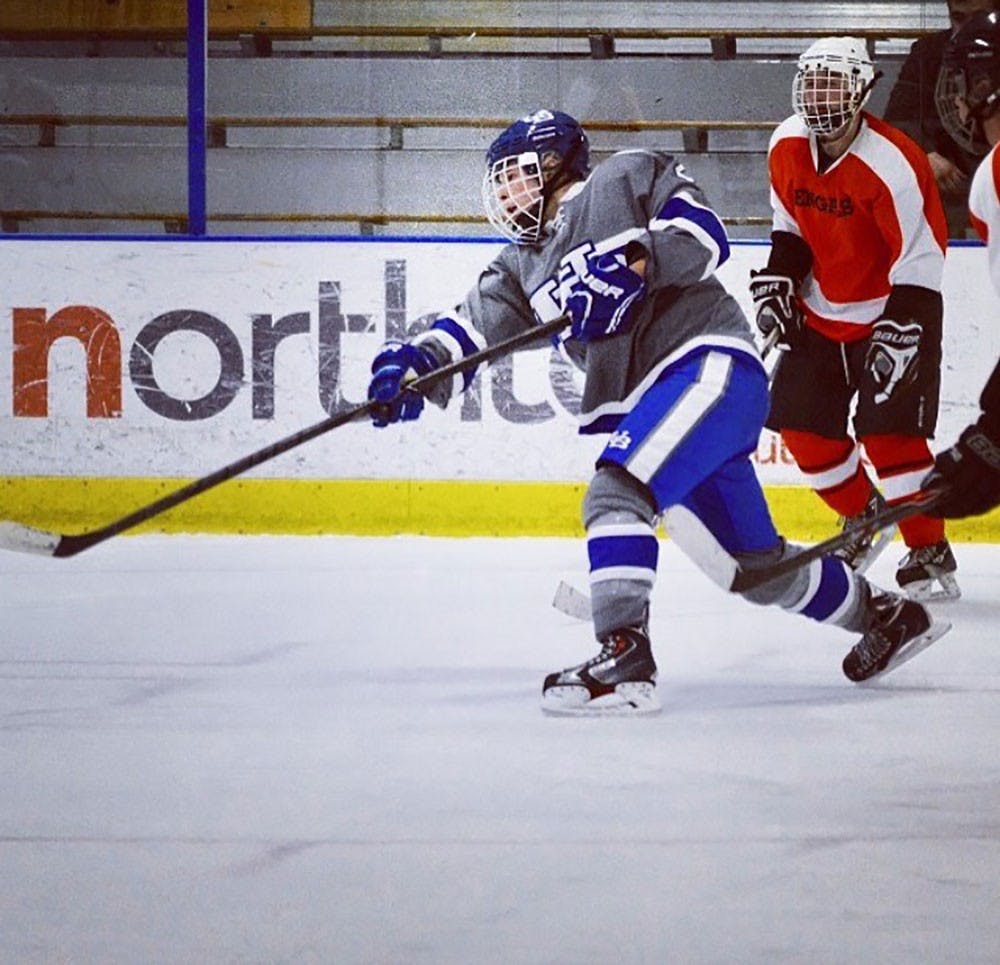“Can I get a whiskey coke,” Gabe Kirsch says at the bar.
Kirsch, a senior hockey player and biomedical science major, inputs the amount of carbs in his whiskey coke into his insulin pump. From there, his insulin pump does all the work, ensuring his blood sugar levels remain steady.
Kirsch has type-1 diabetes. One misstep in his diet could lead to irregularities in his body.
However, Kirsch does not let this disease stop him from doing what he loves, which is to play hockey. He’s part of the UB club hockey team, which has won back-to-back Division III club hockey national titles – the first UB team to win back to back.
“The issue I have is, what happens in your body physiologically is when you start to play hockey, you have adrenaline hormones and what those do is they mobilize your body’s glucose storage for energy,” Kirsch said. “So, for a person like me who doesn’t have the insulin to counteract, a lot of times I’ll have elevated blood glucose cells during a game.”
Type-1 diabetes is typically diagnosed in children and was originally called juvenile diabetes. Only about 5 percent of people with diabetes have type-1, according to the American Diabetes Association. Those with type-1 diabetes suffer from a lack of insulin production. Insulin helps the body to absorb glucose, or sugars.
For every two grams of carbs, Kirsch needs to pump insulin into his body. Every diabetic has a different ratio of carbs to insulin and if not done properly, it can affect everyday tasks, or even sleep.
“Sometimes your sleep would get interrupted, let’s say you eat a late time snack, you give yourself too much insulin and then you start to feel hypoglycemic symptoms while you’re sleeping,” Kirsch said. “So, you have to get up and go eat some carbs.”
Kirsch must always keep an insulin pen on him. His close friends and roommates all know how to use the pen in case of an emergency. Luckily, Kirsch has never had to use the pen.
Kirsch’s friends know how difficult it was for the hockey player to adjust, but admire his determination to overcome the disease and continue playing.
“It doesn’t really affect him, he still goes to school and plays hockey and does all the same things that he did before,” said Kelly Yazwinski, a longtime friend and senior occupational therapy major. “He’s good at hiding it but he loves to talk about it a lot. We make fun of him for it, we rip on him because he always talks about it.”
Kirsch found out he had diabetes his senior year of high school after his hockey season was finished. The following season, at his former school Mercyhurst College, Kirsch sat out due to the disease. He was still adjusting to the daily work that goes into staying healthy and maintaining the right glucose balance.
Jennifer Kirsch, his mother, worried he might not have been ready to start playing again.
“Even for him, he was a little worried about it as well because it was such a new process,” Jennifer said. “The testing, the eating and counting carbs and all that. I think he just wanted to get a handle on it first before he played a sport.”
Jennifer received a phone call from Kirsch’s pediatrician one day while her son was in school, taking an exam. After testing Kirsch’s blood at a regular appointment, the results came back and revealed he had type-1 diabetes.
“When I went into the school [to pick him up] I was crying and he said to me ‘Mom it is going to be OK.’ He was rock solid and I don’t think the whole thing really hit him and I was a wreck and didn’t handle it well at all but he was rock solid,” Jennifer said.
Kirsch remembers the situation vividly. He had a feeling something was wrong with his body. He lost 10 pounds in a matter of a couple months and never realized it until his boss at his job said something to him.
Kirsch was in the hospital for four days. Doctors and nurses taught him what he needed to do to maintain his health with the disease.
“That remorse for myself kind of transitioned quickly because I was in the pediatric unit and so I had all these other little kids that were maybe 10 years old that had also got diagnosed,” Kirsch said. “It was kind of eye opening in a way and I didn’t feel as bad for myself I started feeling bad for these kids that didn’t understand why every time they had to do something so normal such as eating, they had to take a shot.”
Four years after his diagnosis, Kirsch hardly notices the wire that comes out of his shirt, connecting his insulin to his body. Regular checks have become routine and the hockey player has a great sense of what he can and cannot eat or drink.
As for his diabetes on the ice, his teammates don’t take notice of it either.
“His diabetes does not affect his gameplay at all, you could not tell he was diagnosed with it,” said Danny Edmonds, a teammate and roommate. “He was a heavy contributor to our team with his leadership as well as points.”
Kirsch has been able to still do what he loves while never letting diabetes control his life.
“Its definitely a controllable thing.” Kirsch said. “The first month or so there is a adjustment phase. You need to learn how to count carbs efficiently and recognize what your body is telling you.”
Jeremy Torres is a sports staff writer and can be reached at sports@ubspectrum.com





